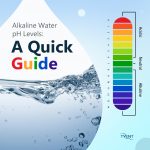Find out why knowing the pH level of your water can make the difference between health maintenance and complicated imbalance.
In this article:
- What Is the pH Level?
- Who Discovered the pH Level?
- How Do I Test My pH Level?
- Where Do pH Levels Differ?
- When Do pH Levels Change?
- Why Is pH Level Important?
- What Is an Easy Way to Keep My pH Levels Balanced?
pH Level: From Every Level of Curiosity, What Is It Exactly?
What Is the pH Level?
The term pH stands for “Potential of Hydrogen,” which measures the hydrogen concentration present at any time. It is usually measured in terms of balance, more specifically the balance between the alkalinity and acidity in our blood.
If a solution is on the lower end of the pH scale, the more acidic it becomes. On the other hand, the higher the pH on the scale goes, to more alkaline a solution is.
A balanced pH level measure to about pH 7 or only slightly higher, but that is not universal. Different levels sustain various systems that depend on the right amount of alkalinity or acidity.
Who Discovered the pH Level?
The concept of the potential of hydrogen (pH) came to be thanks to the Danish chemist Soren Peder Lauritz Sorensen, in 1909 at the Carlsberg laboratory. Definitions, as well as measurements, had to have revisions in 1924 in order to accommodate new terms for electrochemical cells.
But, the first electronic method measuring pH levels was invented in 1934, by a professor at the California Institute of Technology, Orville Beckman. It came as a response to Sunkist — then a known citrus grower — looking for a quick way to measure the pH of newly picked lemons.
How Do I Test My pH Level?

One good way to measure your own pH is to test your saliva. Here is an easy to follow do-it-yourself pH test:
- Get some pH paper, which measures the alkaline-acid state of liquids.
- After a 6-hour sleep, and before first urination, retrieve your pH strips.
- You can test with your urine by urination on it directly or dipping it in a cup with collected urine.
- Performing a saliva test is also a good way; start by rinsing your mouth with water, right before eating, drinking, or brushing after waking up. Collect saliva in a spoon and dip the pH strip in it.
- Once the strip gets wet, it will change color. The resulting color corresponds to acidity or alkalinity; check the chart in the test kit to find out what level your pH is based on the strip.
Where Do pH Levels Differ?
Different parts of our body have varying levels of pH. For example, our stomachs are around the 7.2-7.6 pH level, meaning it’s neutral. The acid in the stomach has an acidic pH to break done foods, and stomach acid should have a pH in the range of 1.5 – 2.2.
Below 6.5 pH levels: Many Americans have low pH levels because their diets are highly likely to form acids. One way to remedy this is to eat more vegetables, fruits, spices, and nuts, which are all alkalizing foods.
Above 7.5 pH levels: A pH level way above 7.5 can be the cause of catabolism, which is a process of body tissue breakdown. It also produces more nitrogen in the urine.
When Do pH Levels Change?
There are several variables and factors that affect pH levels.
The dissolution of carbon dioxide in water can throw off the pH balance in the water. This is because dissolved carbon dioxide is an acid – albeit a weak one.
Carbon dioxide can be brought about in water by decomposition of fish, plants, algae, insects, or as a byproduct of the respiratory processes of breathing underwater creatures.
Acidic and alkaline objects such as soil, rocks, and organic by-products can also affect pH levels as they release minerals upon contact. Such minerals — among which are calcium and sulfides — can turn into acids and alkalines that disturb regular pH levels.
Gaseous chlorine can also greatly reduce pH levels. This is precisely why chlorinated pools require constant attention because once chlorine becomes gas it can really affect a pool’s pH balance.
Pollution and airborne contaminants also affect pH levels. Fine particles carried around by air consist of chemical or organic compounds that transform into acids upon contact with water.
Sulfur dioxides and nitrogen oxides produced by vehicles and manufacturing behemoths also affect pH levels as they transform into acids when combined with water.
RELATED: Are Your Favorite Drinks Alkaline Or Acidic?
Why Is pH Level Important?

The human body requires a natural pH level of 7.4 to be able to function at peak efficiency. When those levels change, it will always want to find ways to return to that specific level.
Drinking water with too many minerals removed and constant consumption of acidic foods will change your body’s pH balance. To change it, you will have to drink more alkaline water, and eat more alkaline-rich foods.
Excess acids in the blood can lead to health complications, such as respiratory or metabolic acidosis. Metabolic acidosis involves an abnormal metabolism caused by the buildup of ketones in the blood and results in the kidney struggling to properly function.
Respiratory acidosis involves the improper expulsion of carbon dioxide from your lungs, which can cause pneumonia or asthma.
On the other hand, alkalosis occurs when there is too much bicarbonate and too little acidity in your blood. This is often caused by overuse of diuretics, thereby increasing the presence of carbon dioxide in the bloodstream.
Symptoms of alkalosis include muscle cramps, twitching, and irritability. Treating alkalosis requires the replacement of fluids to recover the proper acid balance.
What Is an Easy Way to Keep My pH Levels Balanced?
Consuming alkaline-rich foods and acidic foods in moderation is a way to keep your pH balance in check. Make sure to check which foods are more alkaline in nature, and which ones are more acidic.
Another way is to manually alkalize foods and beverages. you can do this by adding lemon to water, or baking soda to rinsing water, but drinking water with baking soda is not recommended due to the high sodium content.
The easiest way is to install your own filtration system that ionizes water to enable you to have access to the kind of water you need at any time of the day. A water ionizer is a good and convenient choice, as they are easy to install on faucets, and are easy to use.
Water ionizers produce up to 70% alkaline water that is safe and healthy to drink and wash fresh produce with. But don’t just throw away the leftover acidic water — you can use it to disinfect your hands, or clean your face and body with, as its acidic, antibacterial properties are potent on bacteria living on human skin.
pH levels don’t serve to complicate water. In fact, it helps give you an idea that this nourishing liquid can take on various forms, and contain different properties that have varying benefits for us and the world we all live in.
Next time you hear about “pH balance,” or “alkalized water,” you’ll know exactly what people are talking about. Hopefully, it even makes you be more aware of what you eat or drink, so as to not disturb the delicate pH balance that keeps your body running.
How do you maintain your own pH levels? Let us know in the comments section below!
Up Next: Five Resolution Solutions: How A Water Ionizer Can Energize Your New Year!











Hi I looked at my pee and it was darkly colored. Low pH? Is that what it is?
Hi, Trevor. Were you able to test your urine with a pH kit? If not, or even if you did, I would still recommend contacting your general health practitioner for a full assessment. If they suggest that you drink alkaline or hydrogen water, please give one of our water ionizer experts a call at 855-893-6887.
Hi, Admin:
I want to test my pH level at home. Where can I get a kit of my own?
Thanks, Adrianna
Hi, Adrianna. We actually have an affordable pH Test Kit that you can purchase from our website.
Lovely article!
My pee is usually clear to lightly yellow so that means that my pH levels are healthy, right?
Hi, Irvin. That’s great news! If your urine doesn’t have much color, it usually means that you’re hydrated and that your pH levels are within a healthy range. You can read more about that here.
Hopefully, you’re drinking six to eight glasses of water a day. You should also help your body stay healthy by getting antioxidants from fruits, veggies, and a good cold glass of alkaline water.
Good to learn about this, guys. Your blog lets me stay in the know.
Hi, Kendra. We’re happy to hear that!
If you’re interested, you can learn more about restoring your body’s pH balance by reading this article.
really informative and helpful. thank you
Hi, Roy. Thanks for your comment. If you’re interested in knowing more about pH levels, you can read this article to learn about how to restore your body’s pH balance.
To alkslize your body fluids is beneficial, but don’t over alkalize check the ph of your Urine with pH strips on a regular basis.
Hi, Pieter. Drinking hydrogen-rich alkaline water from our state-of-the-art water ionizers actually promotes a healthy state of alkalinity in your body, which is within a pH range of 7.35 to 7.45. Please know that it’s very difficult to over-alkalize your body – almost impossible, in fact. We’ve never had anyone tell us that they became too alkaline because of ionized water.
It’s important to drink water with a pH level of 9.5, not higher. If you want to check the pH levels of your water, then you can choose to use pH strips. You can get a pH test kit from us, too.
Do you also have a way to test the pH of home water without a machine? Thank you 🙂
Hi, Montraie. We have our handy pH test kit that you can use with any source of water you may have.
If you want to test the quality of your tap water even further, you can sign up to get a Free Water Report from us! Our water experts will be happy to help you.
How long does the alkaline pH last? Is it forever alkaline once the water comes out of the ionizer?
Hi, Martin. Alkaline water will retain its alkalinity for about 1 to 2 weeks while the hydroxyl ions or antioxidant properties will last for only 18-24 hours. That’s why it’s best to drink fresh alkaline water and to own a water ionizer so that you can continuously replenish your supply.
We’d love to help you get your own ionizer, so if you’re interested, please call us at 855-893-6887.
How can we test the pH of our own water at home? What if it’s low?
Hi, Emma. We have an easy-to-use pH test kit that allows you to quickly check the pH of your water using our reagent drops. If you want to know more about the general quality of your tap water, you can also get a FREE Water Report for your area.
Should your source water’s pH levels be low, that means that your water is acidic and isn’t good for drinking. We’d recommend getting a Tyent water ionizer to ionize your water and turn it into mineral-rich, hydrogen-filled alkaline water that’s great for your body.
We’d love to help you out, so give us a call at 855-893-6887.